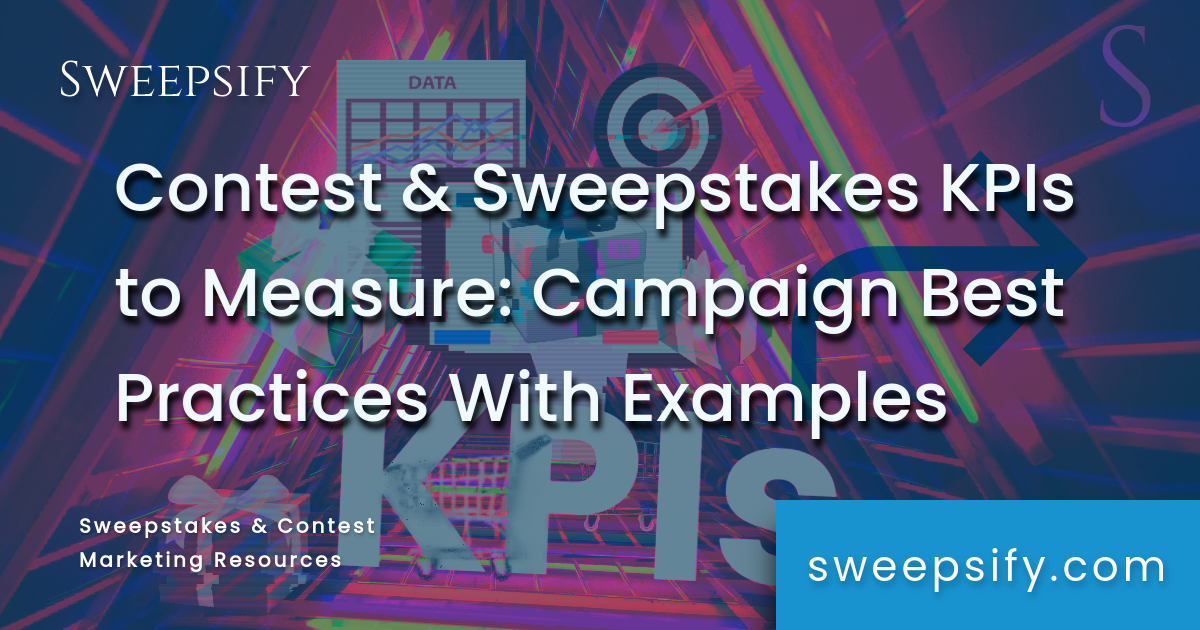Here is a list of our current affiliate partners and how we earn money
Key Performance Indicators (KPIs) for sweepstakes, or sweepstakes KPIs, are the subset of performance indicators for sweepstakes and contests that determine whether your giveaway promotion will deliver ROI. While you may already know that you should track your sweepstakes or contest, you may not know what sweepstakes KPIs indicate that you are on target to achieving your goals. On the other hand, while KPIs and metrics are similar they are not the same: KPIs are designed to be actionable.
via GIPHY
KPIs vs Sweepstakes Metrics Meaning
Here is a quick definition of a contest or sweepstakes KPI vs metric:
- KPIs are the key targets that your sweepstakes or contest needs to hit by certain milestones. An example of a key performance indicator for sweepstakes is “targeted new customers per campaign”.
- Metrics measure the success of the marketing activities that support your KPIs. While they have an impact on your giveaway campaign outcome, they are not the most critical measures of success or failure. Some examples include “sweepstakes entry form visits” or “coupon downloads”
KPIs help you ensure that your contest or sweepstakes supports the overall goals of your organization. In this article, you’ll learn how to define strong KPIs for sweepstakes and contests, KPI examples, and what are the best KPIs to use for giveaway marketing.
Contest and Sweepstakes KPIs to Measure
Don’t have time to read this right now? No problem. Tap the button below to Download the full article as a PDF. Please allow some time for the file to generate.

Article Contents
IN THIS ARTICLE:
- What are the key performance indicators in sweepstakes?
- What are KPIs examples for giveaways?
- How to create a KPI list for sweepstakes and contests
via GIPHY
How to Track Sweepstakes KPIs
Now that you know how importance of contest and sweepstakes KPIs, how will you go about tracking them and reporting your ROI?
There are a few ways:
Native Platform KPI Tracking
Tracking sweepstakes and contest KPIs is possible using the built-in analytics features of the social media platforms, contest and sweepstakes platforms. Marketers can track social media KPIs using Twitter Analytics, Facebook Insights, Instagram Insights, LinkedIn Analytics, YouTube Analytics, and TikTok Analytics. All social media platforms offer general analytics for tracking the social media performance of your sweepstakes or contest.
Contest and sweepstakes platforms also offer their own built-in analytics to help you track active participants. They will not help you track visitors to your site or other customers who are not also participants.
As a result, this method is not ideal for brands who run multichannel sweepstakes because tracking across multiple dashboards and platforms makes it extremely difficult to compare and analyze campaign results.
Design Custom Reports
Building a martech stack for your sweepstakes marketing will allow you to develop custom reporting. Then you’ll be able to compile all of your contest and sweepstakes KPIs into a single, easy to follow dashboard with custom reporting for your sweepstakes administrator, sales and marketing teams, and decision-makers.
Subscribe Now:
via GIPHY
What Are Sweepstakes Vanity Metrics?
Sweepstakes and contests come with all forms of engagement and activity. As a result, marketers need to be able to identify what data is important versus vanity metrics. What are vanity metrics in sweepstakes and contests?
Free Advertisement Maker with Templates
Canva lets you create eye-catching advertisements with their free ad maker. Customize your sweepstakes, contest, or raffle ads with trending images, fonts, and high quality design assets.
ADVERTISEMENT
Simply put, contest vanity metrics are those that make you feel good. They are easy to measure but the data isn’t actionable because it’s either made up of basic quantitative numbers or it’s not time-bound. Vanity metrics can be used in reporting but they don’t actually give you any insight about the success of your promotion.
On the other hand, KPIs are strategic, specific, actionable, achievable, relevant and time-based (SMART) metrics. These clearly defined metrics will influence your marketing team’s decision making. They are also limited to a set of less than 10 key metrics which are always expressed as percentages, averages or ratios.
When sweepstakes KPIs are continuously met during a campaign, the campaign will also show progress towards your desired outcomes/targets. KPIs are designed to measure the accomplishments in your giveaway marketing, not just the work that has been performed.
via GIPHY
Examples of Sweepstakes Vanity Metrics to Avoid
Vanity metrics are typically free or easy to obtain which is why they are still included in many tools used for contest and sweepstakes marketing. Mostly, it’s quick, cheap reporting that doesn’t cost the company anything.
Here are some examples of sweepstakes vanity metrics:
- Link clicks
- Comments and replies
- Post impressions
- Likes
- Social media followers
- Shares
Why don’t these vanity metrics matter? They don’t tell you anything about your participants behavior or tell you who is more likely to become a participant or customer, which are the two things you need to know to optimize your campaign.
via GIPHY
What Is a Good Sweepstakes KPI?
A KPI with all of the elements that you need to generate quantifiable, outcome-based statements includes:
- A measure: Every KPI needs to have measure.
- A target: Every KPI must have a target that matches your measure and the time period for achieving your goal (no longer than the end date of your giveaway promotion). This goal should be a numeric value.
- A data source: Every KPI should have a clearly defined data source, so that there is no confusion around how the data is being tracked and measured.
- Reporting frequency: KPIs each have their own reporting needs, but a good rule to follow is to report on the daily until your contest or sweepstakes ends.
via GIPHY
How to Develop KPIs for Sweepstakes and Contests
With so much data from a giveaway it can be difficult to develop KPIs that are measurable and actually tell you something about the success of your campaign. Here are some best practices for developing the right KPIs.
- Define your campaign goals: Figure out exactly who should use the KPI report from your campaign. Your in-house marketing team and sales teams are two groups that can benefit from the data provided by your campaign.
- Tie sweepstakes KPIs to strategic goals: If your KPIs don’t match what you’re trying to achieve from running sweepstakes and contests, then they don’t make sense. Every key performance indicator should tie directly back to your overall reputation management, marketing, and sales goals.
- Write SMART KPIs: All of your giveaway KPIs should follow the proven SMART formula for developing key performance indicators. Some examples for sweepstakes and contests include “Grow new customers by 10%” or “Increase UGC generation on social media 40% over the next year.”
- Plan to make changes: As you get to know your customers better through sweepstakes and contests, you may need to revise your KPIs. Perhaps you’ve managed to achieve your targets and want to adjust them based on performance. Make sure to create a plan that allows for you to make changes to your KPIs as needed.
- Avoid tracking too many KPIs: Sweepstakes and contests give brands access to tons of data which makes it possible to measure just about anything. Keep in mind that the term KPI refers only to the most critical indicators of performance for a giveaway. Avoid using too many KPIs by focusing only on the ones that are most relevant to and actionable for your business goals.
When considering a KPI, consider first if it will help you to achieve meaningful business results.

Examples of KPIs for Sweepstakes and Contests
Good sweepstakes KPI plans have around 5 to 7 KPIs. As a result, we recommend that you focus on the KPIs that are most related to getting conversions and sales.
1. Social Media Contest KPIs
With so many engagement actions that are possible on social media, it’s easy to get KPI overload.
Here are some examples of social media KPIs:
- Audience growth rate
- Reach
- Potential reach
- Click-through rate (CTR)
- Cost per click (CPC)
- Cost per thousand impressions (CPM)
2. Sales KPIs
These are sales KPIs that you should track in order to determine how many of your participants are becoming first-time customers during and after your sweepstakes or contest, as well as, how much they are spending.
Here are some examples of sales KPIs:
- New participants in the sales funnel
- New qualified opportunities
- Total pipeline value
- Sales volume by location
- Average order value
- Net sales – dollar or percentage growth
3. Customer Experience KPIs
The customer experience KPIs are the KPIs that involve the customer’s interaction with your brand and giveaway promotion. They will help you to determine how much participants are enjoying your promotion and where you can improve.
Here are some examples of customer experience KPIs:
- Net promoter scores (NPS)
- Customer satisfaction score (CSAT)
- Customer acquisition rate (participants who become first-time customers)
- Entry form abandonment rate (visitors who partially complete the entry form before abandoning it)
via GIPHY
Next Steps: Define Your Sweepstakes or Contest Goals
Whether your sweepstakes and contests are absolutely crushing or you have still having trouble hitting your goals, it’s important that you use KPIs to accurately and honestly report on the work. Sweepstakes KPIs may be more difficult to measure, but they’re key to knowing if your giveaway marketing is delivering ROI and what steps you can take to improve.
Looking for a martech tools to help you measure ROI for your next promotion? Sweepsify helps you find top martech companies in seconds. Create your free Premium account now to get started.



